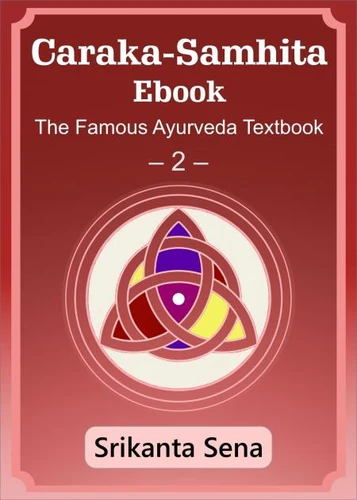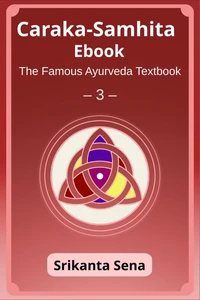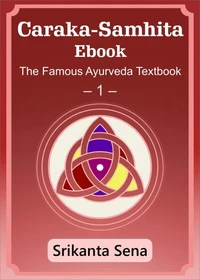Caraka - Samhita Ebook. Caraka - Samhita Ebook, #2
Par :Formats :
Disponible dans votre compte client Decitre ou Furet du Nord dès validation de votre commande. Le format ePub est :
- Compatible avec une lecture sur My Vivlio (smartphone, tablette, ordinateur)
- Compatible avec une lecture sur liseuses Vivlio
- Pour les liseuses autres que Vivlio, vous devez utiliser le logiciel Adobe Digital Edition. Non compatible avec la lecture sur les liseuses Kindle, Remarkable et Sony
 , qui est-ce ?
, qui est-ce ?Notre partenaire de plateforme de lecture numérique où vous retrouverez l'ensemble de vos ebooks gratuitement
Pour en savoir plus sur nos ebooks, consultez notre aide en ligne ici
- FormatePub
- ISBN8223930730
- EAN9798223930730
- Date de parution27/08/2023
- Protection num.pas de protection
- Infos supplémentairesepub
- ÉditeurDraft2Digital
Résumé
The Caraka-Samhita is the oldest and best-known classic of Ayurveda. It was written more than two thousand years ago by the physician and sage Caraka in the Sanskrit language as a textbook for the study of Ayurveda. To this day, the Caraka-Samhita is the indispensable basic work for anyone who wants to fully understand and apply Ayurveda as a physician, therapist or privately for themselves and their loved ones.
Everything worth knowing about Ayurveda that is taught today (and much more) is contained in the Caraka-Samhita.'All suffering is rooted in ignorance, all happiness in pure knowledge.' (Sutrasthanam 30.84) ? 'If I had known this essential knowledge, as presented here in the Caraka-Samhita Ebook, earlier, I would certainly have been spared much suffering.'This is Volume 2 of Caraka-Samhita Ebook. There are four volumes in total containing the eight main parts of Caraka-Samhita:1.
Sutrasthanam (Fundamentals, Basic Principles of Ayurveda)2. Nidanasthanam (Diagnostics)3. Vimanasthanam (Specific characteristics and aspects of do?as, diseases, patients, etc.)4. Sarirasthanam (Anatomy, physiology, conception, pregnancy and birth)5. Indriyasthanam (Signs of imminent death)6. Cikitsasthanam (Therapeutics, 33 chapters)7. Kalpasthanam (Preparations for emesis and purgation)8. Siddhisthanam (Pañcakarma therapies)Each volume contains an appendix with a bibliography, a guide to the pronunciation of Sanskrit, an index of plants, a glossary of Sanskrit words and a list of tables.
In Volume 3 there is also an index of remedies, medicines and dietary preparations mentioned and described in the chapters of the Cikitsasthanam.*******************************************************Table of contents of volume 2 (condensed version without subchapters):IntroductionIII Vimanasthanam (Specific characteristics of patients, diseases, do?as, etc.)? 1 Specific characteristics of rasas? 2 Specific characteristics of diseases? 3 Agni and body constitutions? 4 Specific characteristics of patients? 5 Four groups of parasites? 6 Epidemics? 7 The four yugas? 8 Normal lifespan and premature death? 9 Pramanas - three sources of knowledge? 10 The study of Ayurveda? 11 Factors in determining a therapy? 12 Drugs for pañcakarmaIV Sarirasthanam (anatomy, physiology, conception, pregnancy and birth)? 1 Puru?a and the 24 elements? 2 The causes of suffering? 3 Mok?a - the end of all suffering? 4 About the development of the embryo? 5 Different types of the psyche? 6 Detailed knowledge about the body? 7 Enumeration of the body parts? 8 Conception, pregnancy and birthV Indriyasthanam (signs of approaching death)? 1 Determination of the remaining lifetime? 2 Changes in skin colour and voice? 3 Odour and taste as signs of death? 4 Signs of death that can be recognised by touch? 5 Abnormal sensory perceptions? 6 Prodromes that indicate death? 7 Symptoms of illness that indicate death? 8 Other signs of a doomed person? 9 Dreams that indicate death? 10 Signs of sudden death? 11 General changes before death? 12 Good and bad omensAppendix? Bibliography? Guide to the pronunciation of Sanskrit? List of plants? Glossary of ayurvedic terms? Index of tables
Everything worth knowing about Ayurveda that is taught today (and much more) is contained in the Caraka-Samhita.'All suffering is rooted in ignorance, all happiness in pure knowledge.' (Sutrasthanam 30.84) ? 'If I had known this essential knowledge, as presented here in the Caraka-Samhita Ebook, earlier, I would certainly have been spared much suffering.'This is Volume 2 of Caraka-Samhita Ebook. There are four volumes in total containing the eight main parts of Caraka-Samhita:1.
Sutrasthanam (Fundamentals, Basic Principles of Ayurveda)2. Nidanasthanam (Diagnostics)3. Vimanasthanam (Specific characteristics and aspects of do?as, diseases, patients, etc.)4. Sarirasthanam (Anatomy, physiology, conception, pregnancy and birth)5. Indriyasthanam (Signs of imminent death)6. Cikitsasthanam (Therapeutics, 33 chapters)7. Kalpasthanam (Preparations for emesis and purgation)8. Siddhisthanam (Pañcakarma therapies)Each volume contains an appendix with a bibliography, a guide to the pronunciation of Sanskrit, an index of plants, a glossary of Sanskrit words and a list of tables.
In Volume 3 there is also an index of remedies, medicines and dietary preparations mentioned and described in the chapters of the Cikitsasthanam.*******************************************************Table of contents of volume 2 (condensed version without subchapters):IntroductionIII Vimanasthanam (Specific characteristics of patients, diseases, do?as, etc.)? 1 Specific characteristics of rasas? 2 Specific characteristics of diseases? 3 Agni and body constitutions? 4 Specific characteristics of patients? 5 Four groups of parasites? 6 Epidemics? 7 The four yugas? 8 Normal lifespan and premature death? 9 Pramanas - three sources of knowledge? 10 The study of Ayurveda? 11 Factors in determining a therapy? 12 Drugs for pañcakarmaIV Sarirasthanam (anatomy, physiology, conception, pregnancy and birth)? 1 Puru?a and the 24 elements? 2 The causes of suffering? 3 Mok?a - the end of all suffering? 4 About the development of the embryo? 5 Different types of the psyche? 6 Detailed knowledge about the body? 7 Enumeration of the body parts? 8 Conception, pregnancy and birthV Indriyasthanam (signs of approaching death)? 1 Determination of the remaining lifetime? 2 Changes in skin colour and voice? 3 Odour and taste as signs of death? 4 Signs of death that can be recognised by touch? 5 Abnormal sensory perceptions? 6 Prodromes that indicate death? 7 Symptoms of illness that indicate death? 8 Other signs of a doomed person? 9 Dreams that indicate death? 10 Signs of sudden death? 11 General changes before death? 12 Good and bad omensAppendix? Bibliography? Guide to the pronunciation of Sanskrit? List of plants? Glossary of ayurvedic terms? Index of tables
The Caraka-Samhita is the oldest and best-known classic of Ayurveda. It was written more than two thousand years ago by the physician and sage Caraka in the Sanskrit language as a textbook for the study of Ayurveda. To this day, the Caraka-Samhita is the indispensable basic work for anyone who wants to fully understand and apply Ayurveda as a physician, therapist or privately for themselves and their loved ones.
Everything worth knowing about Ayurveda that is taught today (and much more) is contained in the Caraka-Samhita.'All suffering is rooted in ignorance, all happiness in pure knowledge.' (Sutrasthanam 30.84) ? 'If I had known this essential knowledge, as presented here in the Caraka-Samhita Ebook, earlier, I would certainly have been spared much suffering.'This is Volume 2 of Caraka-Samhita Ebook. There are four volumes in total containing the eight main parts of Caraka-Samhita:1.
Sutrasthanam (Fundamentals, Basic Principles of Ayurveda)2. Nidanasthanam (Diagnostics)3. Vimanasthanam (Specific characteristics and aspects of do?as, diseases, patients, etc.)4. Sarirasthanam (Anatomy, physiology, conception, pregnancy and birth)5. Indriyasthanam (Signs of imminent death)6. Cikitsasthanam (Therapeutics, 33 chapters)7. Kalpasthanam (Preparations for emesis and purgation)8. Siddhisthanam (Pañcakarma therapies)Each volume contains an appendix with a bibliography, a guide to the pronunciation of Sanskrit, an index of plants, a glossary of Sanskrit words and a list of tables.
In Volume 3 there is also an index of remedies, medicines and dietary preparations mentioned and described in the chapters of the Cikitsasthanam.*******************************************************Table of contents of volume 2 (condensed version without subchapters):IntroductionIII Vimanasthanam (Specific characteristics of patients, diseases, do?as, etc.)? 1 Specific characteristics of rasas? 2 Specific characteristics of diseases? 3 Agni and body constitutions? 4 Specific characteristics of patients? 5 Four groups of parasites? 6 Epidemics? 7 The four yugas? 8 Normal lifespan and premature death? 9 Pramanas - three sources of knowledge? 10 The study of Ayurveda? 11 Factors in determining a therapy? 12 Drugs for pañcakarmaIV Sarirasthanam (anatomy, physiology, conception, pregnancy and birth)? 1 Puru?a and the 24 elements? 2 The causes of suffering? 3 Mok?a - the end of all suffering? 4 About the development of the embryo? 5 Different types of the psyche? 6 Detailed knowledge about the body? 7 Enumeration of the body parts? 8 Conception, pregnancy and birthV Indriyasthanam (signs of approaching death)? 1 Determination of the remaining lifetime? 2 Changes in skin colour and voice? 3 Odour and taste as signs of death? 4 Signs of death that can be recognised by touch? 5 Abnormal sensory perceptions? 6 Prodromes that indicate death? 7 Symptoms of illness that indicate death? 8 Other signs of a doomed person? 9 Dreams that indicate death? 10 Signs of sudden death? 11 General changes before death? 12 Good and bad omensAppendix? Bibliography? Guide to the pronunciation of Sanskrit? List of plants? Glossary of ayurvedic terms? Index of tables
Everything worth knowing about Ayurveda that is taught today (and much more) is contained in the Caraka-Samhita.'All suffering is rooted in ignorance, all happiness in pure knowledge.' (Sutrasthanam 30.84) ? 'If I had known this essential knowledge, as presented here in the Caraka-Samhita Ebook, earlier, I would certainly have been spared much suffering.'This is Volume 2 of Caraka-Samhita Ebook. There are four volumes in total containing the eight main parts of Caraka-Samhita:1.
Sutrasthanam (Fundamentals, Basic Principles of Ayurveda)2. Nidanasthanam (Diagnostics)3. Vimanasthanam (Specific characteristics and aspects of do?as, diseases, patients, etc.)4. Sarirasthanam (Anatomy, physiology, conception, pregnancy and birth)5. Indriyasthanam (Signs of imminent death)6. Cikitsasthanam (Therapeutics, 33 chapters)7. Kalpasthanam (Preparations for emesis and purgation)8. Siddhisthanam (Pañcakarma therapies)Each volume contains an appendix with a bibliography, a guide to the pronunciation of Sanskrit, an index of plants, a glossary of Sanskrit words and a list of tables.
In Volume 3 there is also an index of remedies, medicines and dietary preparations mentioned and described in the chapters of the Cikitsasthanam.*******************************************************Table of contents of volume 2 (condensed version without subchapters):IntroductionIII Vimanasthanam (Specific characteristics of patients, diseases, do?as, etc.)? 1 Specific characteristics of rasas? 2 Specific characteristics of diseases? 3 Agni and body constitutions? 4 Specific characteristics of patients? 5 Four groups of parasites? 6 Epidemics? 7 The four yugas? 8 Normal lifespan and premature death? 9 Pramanas - three sources of knowledge? 10 The study of Ayurveda? 11 Factors in determining a therapy? 12 Drugs for pañcakarmaIV Sarirasthanam (anatomy, physiology, conception, pregnancy and birth)? 1 Puru?a and the 24 elements? 2 The causes of suffering? 3 Mok?a - the end of all suffering? 4 About the development of the embryo? 5 Different types of the psyche? 6 Detailed knowledge about the body? 7 Enumeration of the body parts? 8 Conception, pregnancy and birthV Indriyasthanam (signs of approaching death)? 1 Determination of the remaining lifetime? 2 Changes in skin colour and voice? 3 Odour and taste as signs of death? 4 Signs of death that can be recognised by touch? 5 Abnormal sensory perceptions? 6 Prodromes that indicate death? 7 Symptoms of illness that indicate death? 8 Other signs of a doomed person? 9 Dreams that indicate death? 10 Signs of sudden death? 11 General changes before death? 12 Good and bad omensAppendix? Bibliography? Guide to the pronunciation of Sanskrit? List of plants? Glossary of ayurvedic terms? Index of tables






